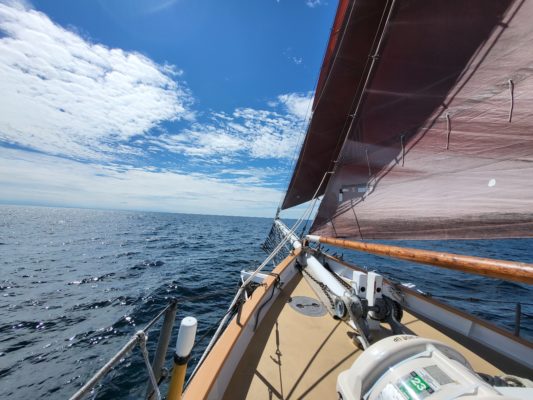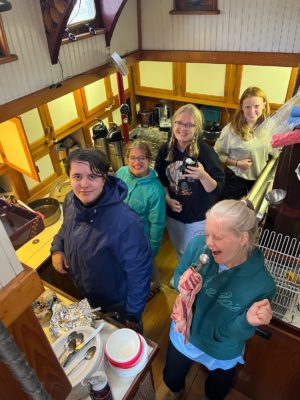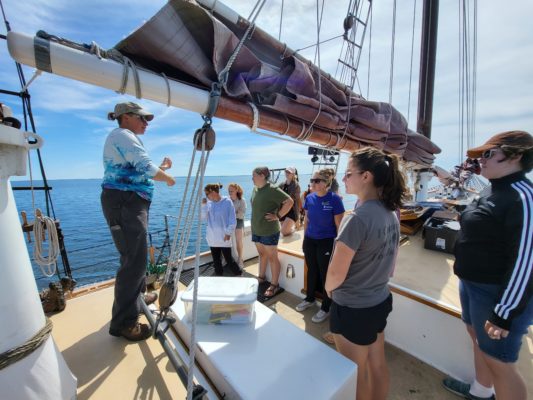From time to time, ISEA will share Great Lakes experiences from guest bloggers. In this blog, a participant in the Young Women in STEM program shares the meaningful water-based education opportunities she received aboard the Inland Seas. Email marketing@schoolship.org if you would like to submit a Great Lakes experience to be featured.
Three days on the Lakes.

Hazy cumulus clouds litter the horizon aft, the waters below cold and rhapsodic; a crew of fourteen aboard a schooner for three days on two of our incredible Great Lakes.
While drafting this blog post I considered the few things I could say to relay my Lake Huron and Lake Michigan experience within the allotted words and the truth is…I might not be able to. I’d like to start off by saying I have no prior experience aboard sailboats or schooners. Everything I know now is due to my time on the Inland Seas. Living on a boat for three days changed my perspective on what I was capable of. It gave me a new awareness of the bore of living on land, and I will go as far as calling myself an aspiring sailor- thanks to the ISEA program.
Being on the ship taught me many valuable lessons. I have a newfound standard of discipline and an extreme respect for the facilitators, researchers, and educators aboard these ships. Everything felt very organized and routine. Each day we would get up at 7:30, eat breakfast, perform our chores and boat checks, and help with casting off and raising sails. We ate three meals a day and drank enough water to stay hydrated. We put on sunscreen and remained on deck when sea-sick. While self-care, safety and fun was stressed, we also learned to live according to our resources, such as limiting our water usage and portion sizes. I was deemed a part of the crew as soon as I boarded the ship. I learned my way around with the help of the educators and crew and I soon became comfortable handling the halyards and coiling lines. It was an inclusive experience which stressed the power of individual capability. I learned that I was much more capable of living this way than I had originally thought.

One of the coolest parts of the program by far was the scientific aspect. Each of the girls was assigned a role to help with collecting research-grade samples from the lakes. Our exploration was analytical and everything we did was recorded. By collecting samples in a trawl that floated near the surface of the water, (one in a rural area and one in a more high traffic) area, we were able to sort out microplastic pieces and compare the density of the pollution. We learned about the dangers of bioaccumulation and the effects of microplastics on the Great Lakes ecosystem. With another net we trawled the benthos (or bottom layer) of the lake. The purpose of this was to collect samples of the species of fish and macroinvertebrates living on the lake floor. We then studied the recent growth of invasive species and the paralleled decline of native fish in the tested areas. This prompted discussion on ways to battle the growing number of foreign species’ invading our waters.
Additionally, we discussed issues such as the structural degradation of plastics (promoted by big business), environmental racism, the problem(s) with recycling programs, and the callous indifference of governments in areas where pollution affects everyday life for many people.
Another integral part of the program is its central initiative to teach young students how to take practical action in response to these issues. Every young woman on board was attentive and engrossed in becoming a steward of the Great Lakes. Whether through direct activism or the creation of infographics, each of us created an action plan to do our part to protect the Great Lakes.

Readjusting to life on land (yes, even after three days) was funny. It’s an odd feeling when the ground isn’t shifting below you, or when someone says they need to use the bathroom: you feel a constant urge to correct their vocabulary, as a ship’s bathroom is typically referred to as the “head.”
I am so lucky to have had this experience with this group of young women. Each of them were so invested in the Young Women in STEM program and I am fully confident that they will become advocates for the protection of the Great Lakes. I walked away from this experience better educated and better equipped to take on these responsibilities, as well as gaining a new idea of my future endeavors. I look forward to using this opportunity to steer my job choice as an ecologist or environmental advocate. If given the opportunity to do it again, I would do it one thousand times over. If you are presented with the chance to go on a Young Women in STEM trip, take it!
Hannah is a student at Alpena High school. She is interested in photography, drawing, playing music and being outdoors with wildlife. She enjoys the Great Lakes through spending time on the water and picking up trash while at the beach.